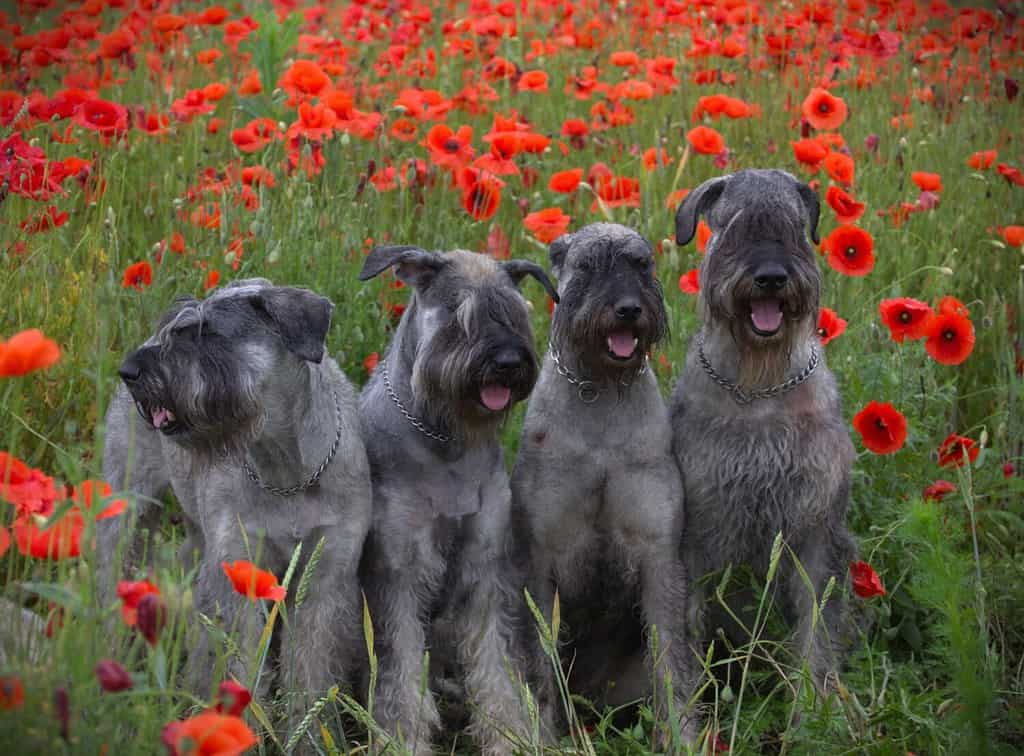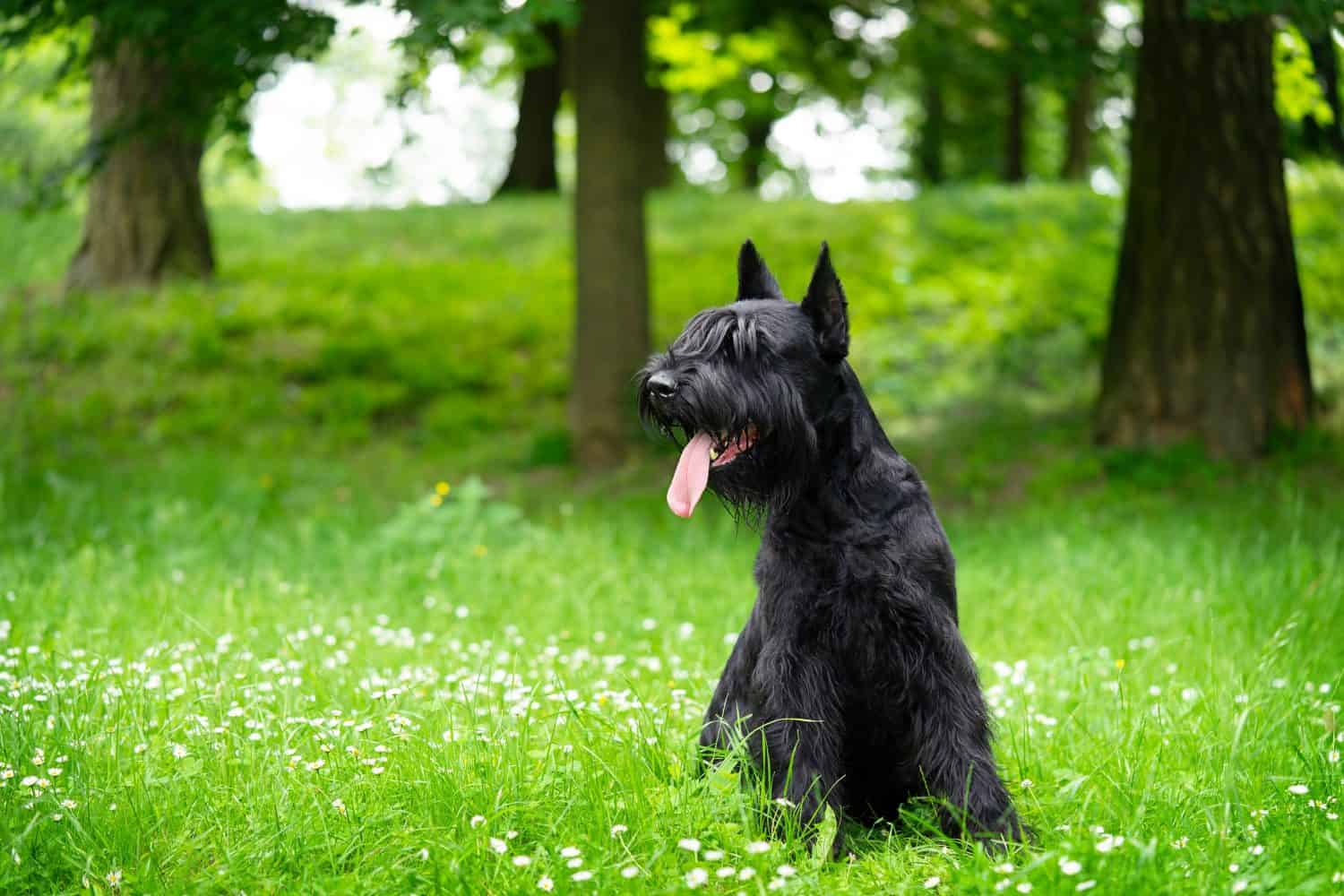When it comes to dogs, few are as noble and proud as the giant schnauzer. Their sharp intelligence, unwavering loyalty, and protective instinct make this breed a perfect addition to any home. If you’ve decided to add one to your family, you might have questions about their progression. Today, we’ll review the expected growth of giant schnauzers during their first two years of life, explore common milestones, and provide new owners with training tips.
Giant Schnauzer Summary

Although giant schnauzers make great family dogs, it’s important that they are socialized early.
©Vladimira Pufflerova/Shutterstock.com
There are three size variants of schnauzer: giant, standard, and miniature. As their name suggests, the giant schnauzer is the largest among these. This breed was developed in Germany during the 1800s and was originally bred to serve as a working animal. Their most popular job was to protect livestock and other assets, but later on, some served in the military and on the police force. Since this time, they have become more popular as companion animals or show dogs.
Giant Schnauzer Growth and Weight Chart by Age
The growth of your giant schnauzer will depend on their gender and genetics. In general, these dogs will grow to be somewhere between 23 and 28 inches tall, and they will weigh somewhere between 55 and 90 pounds at maturity.
| Age | Male Weight | Female Weight |
|---|---|---|
| Birth | 1.5-2 lbs | 1.5-2 lbs |
| 1 month | 5-12 lbs | 4-10 lbs |
| 2 months | 12-20 lbs | 10-18 lbs |
| 3 months | 20-27 lbs | 18-25 lbs |
| 4 months | 27-32 lbs | 25-30 lbs |
| 5 months | 32-37 lbs | 30-35 lbs |
| 6 months | 37-50 lbs | 35-45 lbs |
| 7 months | 45-60 lbs | 40-55 lbs |
| 8 months | 50-65 lbs | 50-60 lbs |
| 9 months | 60-75 lbs | 60-70 lbs |
| 10 months | 70-80 lbs | 65-75 lbs |
| 12 months | 75-85 lbs | 70-80 lbs |
| 18 months | 85-90 lbs | 75-85 lbs |
When Will My Giant Schnauzer Stop Growing?
During their first year of life, giant schnauzers will go through an incredible growth spurt. This will taper off sometime after 12 months of age, and they will be completely done growing sometime between 16 and 19 months old.
How Big Will My Giant Schnauzer Be When It’s Fully Grown?

The giant schnauzer was bred by crossbreeding standard schnauzers and Great Danes.
©iStock.com/Nemyrivskyi Viacheslav
At maturity, a giant schnauzer will usually weigh somewhere between 55 and 90 pounds. Where your dog falls within this range will depend on a few different factors such as their gender, the amount of exercise they get per day, and the type of food they eat.
The Biggest Giant Schnauzer Ever Recorded
Although there isn’t a dog recorded as holding the record for “The Biggest Giant Schnauzer Ever,” many people cite that the largest one grew to be roughly 140 pounds. Whether this is true or not is hard to say. However, giant schnauzers are one of the largest dog breeds in the world, and it isn’t unheard of for them to weigh in the triple digits!
When Should My Giant Schnauzer Be Spayed or Neutered?
Although some breeders opt to neuter or spay their animals before selling them, this isn’t always the case. Vets usually recommend letting larger breeds have a little more time to develop before undergoing this procedure. Because of this, owners should schedule their giant schnauzer’s neuter or spay appointment sometime around 12 to 18 months old.
When Should My Giant Schnauzer Be House Broken?

Giant schnauzers have high exercise needs.
©Tetiana Tychynska/Shutterstock.com
Owners can begin potty training their puppies as soon as they bring them home for the first time. This process can take a little while, but many giant schnauzers will be fully housebroken by six months old. However, in some cases, it can take up to one year to fully potty train this breed.
When Should My Giant Schnauzer Stop Eating Puppy Food?
Many vets recommend keeping your giant schnauzer on a diet of large-breed puppy food until they are roughly 18 months old. However, some owners choose to keep them on this diet until they have reached two years of age. After this, owners can transition them to adult dog food.
When Will My Giant Schnauzer Start Losing Teeth?
According to the American Kennel Club, “By the time, your puppy is about six months old or so, all of his puppy teeth should have fallen out, and his adult teeth should have grown in … If you notice any baby teeth remaining, make sure to let your veterinarian know as they may need to be removed.” Talk to your veterinarian if you have any concerns regarding your giant schnauzer’s teeth.
When Should I Start Training My Giant Schnauzer?

Most owners report that training their giant schnauzers was a relatively easy process.
©photosounds/Shutterstock.com
As we stated earlier, owners may begin training their giant schnauzers as soon as they bring them home. this breed is highly intelligent, and while they’re young, they’re able to soak up a lot of information.
What Cues Should I Teach My Giant Schnauzer First?
When you first begin training your giant schnauzer, start with simple commands like “sit,” “stay,” and “come.” After your dog has mastered the basics, you can move on to more complex commands like “roll over,” “play dead,” or “lie down.”
When Will My Giant Schnauzer Calm Down?

At six months old, giant schnauzers are rarely this calm.
©Rita_Kochmarjova/Shutterstock.com
There’s no denying that giant schnauzer puppies are balls of energy. For many owners, it might feel like this energy has no bounds, but luckily, it will taper off. Many owners report that their giant schnauzers begin to calm down somewhere around three and a half to four years of age.
Common Health Issues Your Giant Schnauzer Might Experience
In general, giant schnauzers are a healthy breed. Although many go their whole life without facing serious health complications, it’s important that owners are aware of potential issues that they might face. Some of the most common health issues in giant schnauzers are hip dysplasia, vision problems, hypothyroidism, and osteochondritis dissecans.
The photo featured at the top of this post is © Photobox.ks/Shutterstock.com
Ready to discover the top 10 cutest dog breeds in the entire world?
How about the fastest dogs, the largest dogs and those that are -- quite frankly -- just the kindest dogs on the planet? Each day, AZ Animals sends out lists just like this to our thousands of email subscribers. And the best part? It's FREE. Join today by entering your email below.
Thank you for reading! Have some feedback for us? Contact the AZ Animals editorial team.






